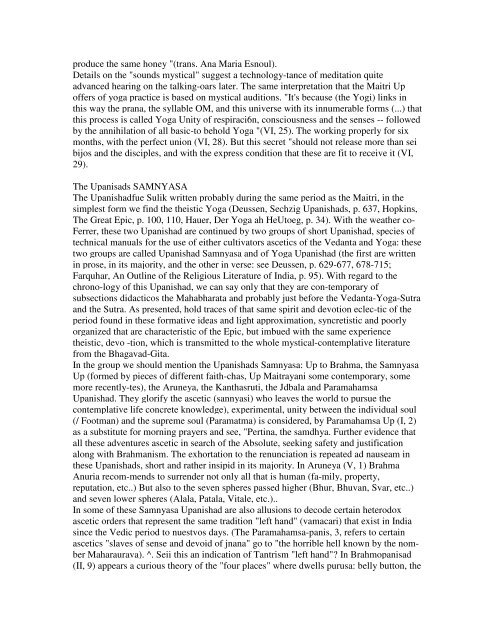Mircea Eliade YOGA IMMORTALITY AND ... - Brihaspati.net
Mircea Eliade YOGA IMMORTALITY AND ... - Brihaspati.net
Mircea Eliade YOGA IMMORTALITY AND ... - Brihaspati.net
You also want an ePaper? Increase the reach of your titles
YUMPU automatically turns print PDFs into web optimized ePapers that Google loves.
produce the same honey "(trans. Ana Maria Esnoul).<br />
Details on the "sounds mystical" suggest a technology-tance of meditation quite<br />
advanced hearing on the talking-oars later. The same interpretation that the Maitri Up<br />
offers of yoga practice is based on mystical auditions. "It's because (the Yogi) links in<br />
this way the prana, the syllable OM, and this universe with its innumerable forms (...) that<br />
this process is called Yoga Unity of respiraci6n, consciousness and the senses -- followed<br />
by the annihilation of all basic-to behold Yoga "(VI, 25). The working properly for six<br />
months, with the perfect union (VI, 28). But this secret "should not release more than sei<br />
bijos and the disciples, and with the express condition that these are fit to receive it (VI,<br />
29).<br />
The Upanisads SAMNYASA<br />
The Upanishadfue Sulik written probably during the same period as the Maitri, in the<br />
simplest form we find the theistic Yoga (Deussen, Sechzig Upanishads, p. 637, Hopkins,<br />
The Great Epic, p. 100, 110, Hauer, Der Yoga ah HeUtoeg, p. 34). With the weather co-<br />
Ferrer, these two Upanishad are continued by two groups of short Upanishad, species of<br />
technical manuals for the use of either cultivators ascetics of the Vedanta and Yoga: these<br />
two groups are called Upanishad Samnyasa and of Yoga Upanishad (the first are written<br />
in prose, in its majority, and the other in verse: see Deussen, p. 629-677, 678-715;<br />
Farquhar, An Outline of the Religious Literature of India, p. 95). With regard to the<br />
chrono-logy of this Upanishad, we can say only that they are con-temporary of<br />
subsections didacticos the Mahabharata and probably just before the Vedanta-Yoga-Sutra<br />
and the Sutra. As presented, hold traces of that same spirit and devotion eclec-tic of the<br />
period found in these formative ideas and light approximation, syncretistic and poorly<br />
organized that are characteristic of the Epic, but imbued with the same experience<br />
theistic, devo -tion, which is transmitted to the whole mystical-contemplative literature<br />
from the Bhagavad-Gita.<br />
In the group we should mention the Upanishads Samnyasa: Up to Brahma, the Samnyasa<br />
Up (formed by pieces of different faith-chas, Up Maitrayani some contemporary, some<br />
more recently-tes), the Aruneya, the Kanthasruti, the Jdbala and Paramahamsa<br />
Upanishad. They glorify the ascetic (sannyasi) who leaves the world to pursue the<br />
contemplative life concrete knowledge), experimental, unity between the individual soul<br />
(/ Footman) and the supreme soul (Paramatma) is considered, by Paramahamsa Up (I, 2)<br />
as a substitute for morning prayers and see, "Pertina, the samdhya. Further evidence that<br />
all these adventures ascetic in search of the Absolute, seeking safety and justification<br />
along with Brahmanism. The exhortation to the renunciation is repeated ad nauseam in<br />
these Upanishads, short and rather insipid in its majority. In Aruneya (V, 1) Brahma<br />
Anuria recom-mends to surrender not only all that is human (fa-mily, property,<br />
reputation, etc..) But also to the seven spheres passed higher (Bhur, Bhuvan, Svar, etc..)<br />
and seven lower spheres (Alala, Patala, Vitale, etc.)..<br />
In some of these Samnyasa Upanishad are also allusions to decode certain heterodox<br />
ascetic orders that represent the same tradition "left hand" (vamacari) that exist in India<br />
since the Vedic period to nuestvos days. (The Paramahamsa-panis, 3, refers to certain<br />
ascetics "slaves of sense and devoid of jnana" go to "the horrible hell known by the nomber<br />
Maharaurava). ^. Seii this an indication of Tantrism "left hand"? In Brahmopanisad<br />
(II, 9) appears a curious theory of the "four places" where dwells purusa: belly button, the







